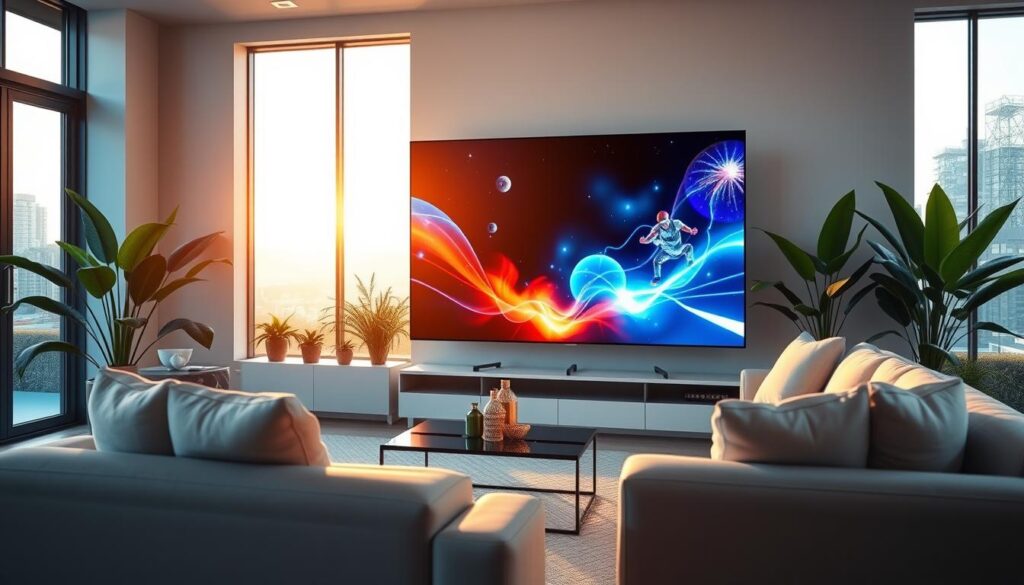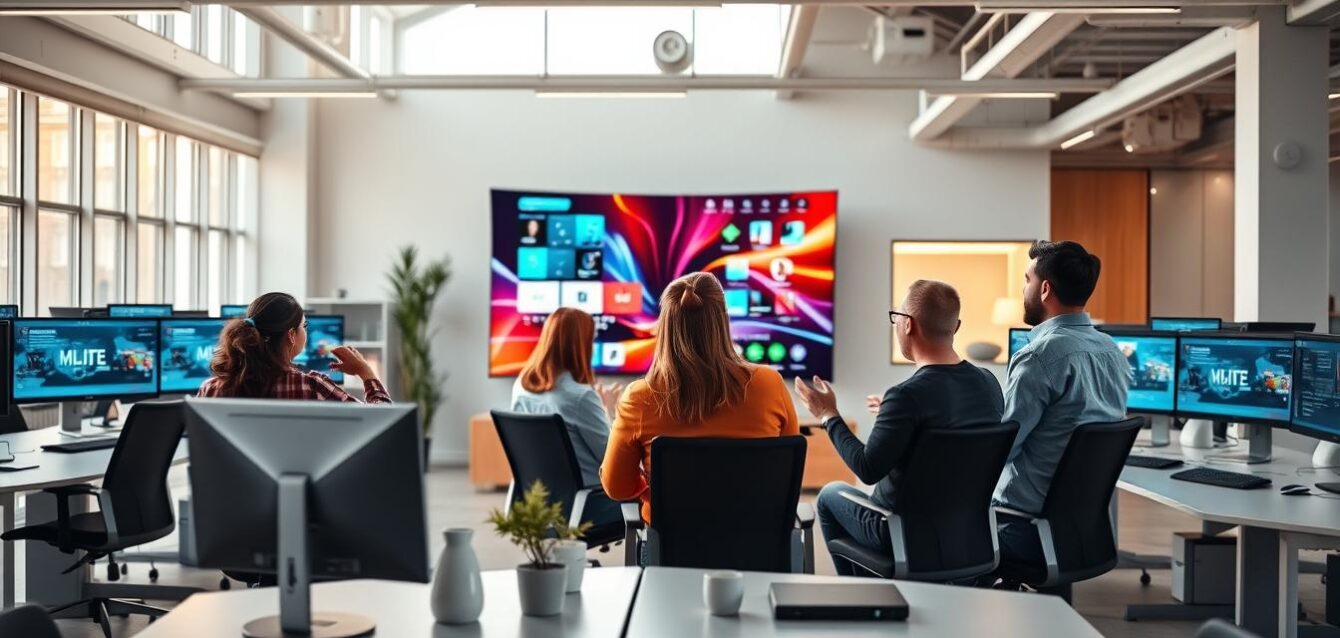Nearly 40% of TV minutes now stream, and that shift is bleeding budgets from legacy buys into unmeasured reach. We open with that scale because growth leaders must stop treating living-room attention as optional.
We will give a clear, data-backed comparison of big-screen impact versus mobile-first precision. Expect apples-to-apples analysis of devices, formats, cost, fraud, and measurement so teams don’t pay TV premiums for mobile video dressed up as television.
Our view is simple: start with living-room reach to build recall and co-viewing, then retarget with efficient online video and display to convert. That system lowers waste, stabilizes CAC, and scales a premium brand across platforms.
Macro Webber presents an actionable Growth Blueprint with metrics, examples, and clean-room validation so leadership can approve spend with confidence. Ready for a decisive path? We map the next steps — from strategy to consult — to protect margin and accelerate revenue.
Key Takeaways
- Streaming commands major TV time; legacy buys risk wasted budget.
- We compare big-screen reach with precision mobile video for clear ROI.
- Start with living-room awareness, then retarget to drive action.
- We use Nielsen, Innovid, and MRC/TAG standards for valid measurement.
- Macro Webber’s Growth Blueprint turns attention into predictable revenue.
Streaming is Eating TV: Why This Decision Matters Now for Growth-Minded Brands
Nearly half of TV minutes have migrated to streaming, creating a decisive advantage for marketers who act now.
The attention gap is real. Young audiences spend roughly 60% of their television time on streaming services. Smart tvs and connected devices are ubiquitous, and ad‑supported tiers on major services expand premium content reach.

The shift and what it means for performance teams
Follow the viewers, not legacy schedules. Budgets stuck in cable-era buys risk wasted GRPs and fractured measurement. We consolidate buys across platforms to avoid duplication and stabilize frequency.
“Streaming turns living rooms into unified households. Reach there drives recall and multiplies return when paired with precision retargeting.”
Hooking the biggest screen without linear waste
- Household reach: tvs concentrate co-viewing and superior recall.
- Timing: ad-supported services open reliable peak windows for brand-safe content.
- Risk control: we cap exposure across screens to prevent frequency inflation.
| Metric | Legacy Cable | Streaming & Smart TVs |
|---|---|---|
| Household Reach | Broad but imprecise | Targeted, co-viewing dense |
| Measurement | GRPs, limited granularity | Person-level panels + big data |
| Cost Efficiency | High waste, fixed CPMs | Calibrated CPMs by platform value |
Executive clarity matters. We translate streaming outcomes into reach, lift, traffic, and conversions so leadership can approve spend with confidence.
OTT vs. CTV: The Difference, the Devices, and Why It Affects Your ROI
Delivery rail and viewing device drive very different economics — we map that gap for practical buys.
Definitions that matter: OTT is the delivery method over the internet. CTV is the device in the living room. All CTV runs on OTT, but not all OTT runs on big screens. This difference dictates cost, attention, and measurement.
Devices and access: smart tvs, Roku, Amazon Fire, Apple TV, PlayStation, and Xbox sit in shared spaces. Mobile, tablet, and desktop deliver personal streams and interaction. Each device changes viewability and format options.
Monetization, formats, and behavior
SVOD (Netflix), AVOD (Tubi, PlutoTV), TVOD (iTunes), FAST (The Roku Channel), and vMVPDs (YouTube TV) each sell different value. On big screens, unskippable spots and near‑100% completions drive recall.
On personal devices, pre-roll, mid-roll, and banners are often skippable. That makes targeting and conversion stronger, but attention weaker.
- Example: Amazon Prime on a Roku TV delivers shared exposure; the same show on a phone is a different outcome and price.
- Risk: paying big‑screen rates for mobile streams creates budget leakage; enforce device-level validation.
| Feature | Big Screen (tvs) | Personal Devices (mobile/desktop) |
|---|---|---|
| Typical completion | Very high, often unskippable | Variable; many skippable views |
| Primary KPI | Reach, lift, recall | Clicks, conversions, precise targeting |
| Cost logic | Premium CPM for household impact | Efficient CPM for response and scale |
Our rule: use ctv ott selectively — big screens for brand scale, small screens for response, then orchestrate them as one system. Confirm MRC/TAG reporting and household context before you pay a premium.
CTV / OTT Advertising Performance: Attention, Completion, and Co‑Viewing at Scale
When ads run on living‑room devices, completion and recall become primary business drivers. We translate those mechanics into clear commercial outcomes: attention that converts to brand lift, higher completion that secures view-through, and co‑viewing that multiplies reach per impression.

Why big‑screen spots drive measurable lift
Unskippable formats on large screens force near‑100% completions. That reliable exposure turns paid reach into true view time and measurable recall.
Co‑viewing multiplies impact
Household viewing means one impression often equals multiple viewers. That compounds recall and speeds preference shifts for premium content shown on tvs.
Interactive trends that add response without breaking experience
We layer QR overlays, shoppable moments, and choose‑your‑path units to create response paths from the living room.
- GenAI creative: dynamic scenes and adaptive CTAs that match household context.
- Measurement: on‑device completion, household reach, and downstream web/app events tie exposure to outcomes.
- Optimization: frequency caps by device and variant testing to scale winners with confidence.
| Metric | Mechanic | Business impact |
|---|---|---|
| Completion | Unskippable spots on screens | Higher recall; improved ad recall rates |
| Co‑viewing | Household multiplies impressions | Lower eCPM per viewer; faster brand lift |
| Interactivity | QR, shoppable, choice units | Extended engagement; measurable response paths |
Data point: interactive formats can add meaningful engagement—Innovid reports longer average viewing and materially higher recall—proof that premium attention pays back. We advise advertisers to measure both attention and downstream actions to validate creative ROI.
Targeting, Measurement, and Attribution Across Devices
A unified identity layer turns household reach into traceable desktop and mobile conversions. We connect exposures to outcomes so marketers can stop guessing and start optimizing.
Identity & cross-device linkage: we use LiveRamp-style graphs to map household views to mobile and desktop behavior. This privacy-first match preserves user anonymity while giving marketers line-of-sight from exposure to action.
Brand lift and attention metrics
Measure what matters. Run Innovid and Nielsen lift studies to validate awareness, consideration, and attention. Those mid‑funnel signals predict downstream performance and justify premium platform spend.
Unified dashboards and clean-room collaboration
We centralize reporting: reach, frequency, completions, and assisted conversions in one dashboard. Clean-room joins let publishers and advertisers validate incrementality without sharing raw PII.
From exposure to outcome
“Translate impressions into attributable revenue, CAC efficiency, and brand equity lift with multi-touch and geo-experimental frameworks.”
- Formalize attribution with multi-touch and geo tests to balance precision and statistical rigor.
- Standardize partners: LiveRamp, Innovid, Nielsen, and MRC/TAG vendors for defensible insights.
- Orchestrate campaigns with frequency discipline and cross-device suppressions to protect audience value.
Outcome focus: tie impressions to pipeline velocity, CAC/LTV, and halo effects. We deliver a measurement stack that proves performance and preserves brand equity.
Cost, Fraud, Fragmentation, and Privacy: The Real-World Tradeoffs
Budget discipline matters: premium big‑screen buys must prove household lift before we pay a premium.
We benchmark cost first. Typical CTV CPMs sit in the $20–$40 range. We pay top rates only when completion, co‑viewing, and attention drive demonstrable lift.
Cheaper ott advertising on personal devices often wins for frequency and interactivity. We reserve big‑screen buys for reach and brand impact, then retarget to convert.
Mitigating fraud and validating supply
Fraud vectors include device spoofing, non‑viewable inventory, and low‑quality reselling. We neutralize these risks with a strict playbook.
- Procurement: buy via PMPs and preferred deals to control inventory and lanes.
- Verification: enforce pre‑bid filters and MRC/TAG‑accredited vendors to block spoofed traffic.
- Contracts: demand make‑goods for invalid traffic and outcome‑based SLAs.
Fragmentation, SPO, and platform choice
SPO reduces hops, lowers fees, and improves inventory quality. Fewer platforms mean cleaner pipes and faster optimization.
Walled gardens—Roku, Amazon, YouTube TV—offer consistent scale but trade off openness. We balance them with open exchange access to keep price leverage.
| Issue | Risk | Mitigation |
|---|---|---|
| Cost | High CPMs ($20–$40+) | Tiered buys: big screens for lift, personal devices for frequency |
| Fraud | Device spoofing, non‑viewable | PMPs, pre‑bid filters, MRC/TAG partners |
| Fragmentation | Supply hops, inconsistent quality | SPO, fewer platforms, walled garden balance |
| Privacy | Loss of third‑party IDs | First‑party data, contextual, clean‑room PETs |
Future‑proofing for privacy
We shift to household and first‑party signals, contextual targeting, and privacy enhancing technologies. Clean‑room joins let publishers and advertisers measure lift without exposing raw PII.
“Our playbook protects margin: right‑size budgets across devices, insist on verified inventory, and lock contracts to performance.”
Executive playbook: align SLAs to outcomes, standardize reconciliation across channels and platforms, and treat price as one input—attention and verified delivery complete the equation.
When to Choose CTV, When to Choose OTT, and How to Combine Them
Match intent to channel: choose living‑room impact for recall and mobile/desktop for conversion. We give crisp rules leaders can deploy now.
When to choose the big screen: use household targeting when you need brand lift, premium adjacency, and co‑viewing scale. Own the living room to build memory structures and trigger downstream search and direct traffic.
When to choose personal devices: use personal streams for clicks, installs, and efficient frequency. Optimize creative for interaction and lower CPMs on mobile and desktop.
Full‑funnel playbook (step by step)
- Launch: flight big‑screen buys first with tight household targeting to seed awareness.
- Collect: build retargeting pools via pixels and identity graphs to unify audiences across platforms.
- Activate: run short‑form online video on YouTube, Meta, and TikTok to reinforce the story.
- Layer: add programmatic display, audio, and owned channels (email/SMS) to accelerate conversion.
- Calibrate frequency: target 1:1 for awareness; increase to 1:1.5 when optimizing for performance.
- Measure: combine geo‑lift tests, MMM, and clean‑room studies for defensible attribution.
- Govern: one operating plan across platforms with negative lists and budget guardrails to stop internal bidding wars.
| Objective | Channel | Creative |
|---|---|---|
| Awareness | Living‑room big screen | Master, cinematic :30 |
| Consideration | Short online video | Cutdowns, social edits |
| Conversion | Mobile / Desktop | Product‑forward, clickable CTAs |
Operational cadence: weekly optimizations on audiences and bids; monthly roadmap updates to compound gains. We standardize attribution and creative sequencing so marketing leaders can scale with confidence.
Conclusion
Conclusion
Build a single playbook that treats living‑room recall and online response as one profit engine.
Streaming and television are converging. Smart tvs and platforms like Amazon Prime and Amazon Fire put your audience on top screens. That creates a rare window to win share and memory.
We de‑risk execution with supply controls, SPO, PMPs, and strict measurement. Validate devices and screens, insist on lift studies, and tie exposure to business KPIs with clear data dashboards.
Our verdict: ctv advertising leads for premium reach and co‑viewing; ott content complements with precision and interactivity. Creative built for the living room, plus cutdowns for smaller devices, compounds returns.
Act now. Book Macro Webber’s Growth Blueprint this month to lock Q4 placements, secure priority onboarding into WebberXSuite™, and deploy the A.C.E.S. Framework. Limited enterprise slots—reserve your consultation and turn screen time into measurable revenue.



